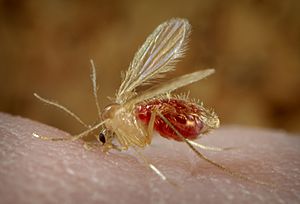Sandfly facts for kids
Quick facts for kids Sand flies |
|
|---|---|
 |
|
| Phlebotomus papatasi | |
| Scientific classification | |
| Kingdom: | |
| Phylum: | |
| Class: | |
| Order: | |
| Suborder: | |
| Family: |
Psychodidae
|
| Subfamily: |
Phlebotominae
|
Sandflies are very small flies. Many types of sandflies feed on blood. They can also carry and spread tiny germs that cause diseases. These germs are called parasites. The group of flies known as sandflies is called Phlebotominae.
Contents
Sandflies: Tiny Blood-Suckers
Sandflies are known for spreading certain diseases. These include leishmaniasis, bartonellosis, and pappataci fever. These diseases can make people or animals very sick.
Where Do Sandflies Live?
Sandflies live in many parts of the world.
- In the New World (like North and South America), sandflies from the group Lutzomyia spread leishmaniasis. These flies often live in caves. Their main food source there is bats.
- In the Old World (like Europe, Asia, and Africa), sandflies from the group Phlebotomus spread leishmaniasis.
Why Do Sandflies Bite?
Only female sandflies bite and suck blood. They get blood from different animals. This includes mammals, reptiles, and birds. Some sandfly types are picky about who they bite. Others will bite almost any animal they find.
Female sandflies need a blood meal to make their eggs. The blood gives them the Proteins and other important things they need. Without blood, they cannot produce eggs. One blood meal can help a female sandfly make about 100 eggs.
When a sandfly bites, it uses its mouthparts to make the host bleed. Then, it sucks up the blood. Like most insects that feed on blood, sandflies inject special liquids. These liquids help stop the blood from clotting. This makes it easier for them to drink the blood.
How Do Sandflies Lay Eggs?
Female sandflies lay their eggs in damp soil. This soil needs to have lots of decaying plants or other natural materials. This helps the eggs grow.
Sandfly Bites and Protection
Sandflies are tiny, usually about 3 millimeters long. Their small size helps them go unnoticed. You might not even feel their bite right away.
A sandfly bite often leaves a small, red bump. This bump usually starts to itch hours or even days later. If you are in an area where sandflies live, it's a good idea to use insect repellent. This can help protect you from their bites.
Images for kids
-
A swarm of sandflies at Georges River National Park (Australia)




